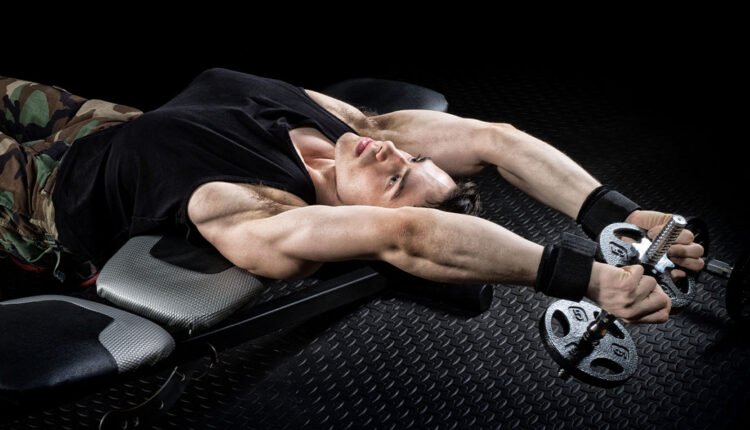The dumbbell pullover may be the best old-school exercise you are not doing.
It was a favorite of the bodybuilding greats, including Arnold Schwarzenegger, Ronnie Coleman, and Dorian Yates. This exercise helped get their massive chests and backs that were the envy of the bodybuilding world. If it was good enough for them, it should be good enough for you.
Although it may be neglected by the new era of gymgoers, most old-school moves will find a way back to the training mainstream. And the time is now to begin getting reacquainted with the dumbbell pullover.
Here we’ll dive deep into the dumbbell pullover so you can build slabs of upper body muscle for more flex appeal.
What is the Dumbbell Pullover
At its core, the dumbbell pullover is an exercise that trains the chest and lats without using your biceps and triceps. Not using these muscles limits your weight, but more emphasis will be on your chest and lats. Lying on a bench and bringing the dumbbell behind puts an incredible pre-stretch on the working muscles for better muscle-building potential due to the extensive range of motion.
How To Do The Dumbbell Pullover
- Hold the dumbbell underneath with both hands by your chest.
- Set up similarly as you would for the hip thrust exercise. Put your upper back lengthwise on a flat weight bench, perform a hip extension, and press the dumbbell over your chest.
- Ensure your knees are at a 90-degree position, and engage your core and glutes.
- With a soft bend in your elbows, lower the dumbbell behind your head while keeping your elbows pointed forward.
- Lower to your preferred depth while maintaining a good posture.
- Pullover back to the starting position and reset and repeat.
Muscles Trained
The dumbbell pullover is primarily an upper-body exercise with assistance from the lower body (depending on body position) to maintain a neutral spine. Here are the major muscles trained by the dumbbell pullover.
- Serratus anterior: This exercise must be part of your routine if you want a serrated Serratus anterior. It aids in the protraction and upward rotation of your shoulder blades, and both functions are trained during the pullover.
- Lats: The lats are the prime mover as they extend the shoulders during the pullover. But the lats money is made during the eccentric part as when put under a loaded stretch.
- Triceps: Triceps work isometrically and are under load due to the slight bend in your elbows.
- Pectorals: During the dumbbell pullover’s concentric phase, you’ll use your pecs (your chest) via shoulder flexion and pulling your arms together. To emphasize the chest more, keep your arms as straight as possible.
Benefits of the Dumbbell Pullover
The dumbbell pullover is a simple exercise, and because of that, its benefits are overlooked. Seeing that I’m bringing old-school back, here are the tried and true benefits of performing dumbbell pullovers.
- Upper Body Muscle: You are limited in the weight you’ll use with the dumbbell pullover because of the dumbbell’s freedom of movement and body position. But it does have one advantage over many exercises: its extensive range of motion and the loaded stretch on the lats. When performed for higher reps, the time under tension on the chest and lats is incredible.
- Improved Shoulder Mobility: As the dumbbell pullover provides a loaded stretch on the lats and triceps, two muscles responsible for overhead shoulder mobility, it can help shoulder mobility. Just ensure you perform with good form and avoid the mistakes discussed below.
- Stronger Stabilizers: When you’re in the hip extension position, holding a heavy dumbbell and working through a large ROM, you’ll strengthen many stabilizer muscles, including your anterior core, upper back/shoulder blades, and glutes. Improved stabilizer strength allows the bigger muscles to do their job better.
Dumbbell Pullover Form Fixes
The dumbbell pullover is a simple exercise, but you need to watch out for simple mistakes that take away from the effectiveness of the exercise. Here are a few pullover mistakes to keep an eye on.
- Artificial Range Of Motion: If you have limited overhead shoulder mobility, try the variations below combined with shoulder mobility drills to improve your shoulder mobility. Some lifters ‘force’ extra range of motion by hyperextending their low back and losing ribcage positioning, then all core strengthening benefits go bye-bye. Squeezing your glutes and keeping your lower ribcage down is imperative with the dumbbell pullover.
- Don’t Bend The Elbows…..Too Much: Like Goldilocks and the three bears, there is too much, too little, and just the right amount of elbow bend. Excessive elbow bending during the eccentric puts more emphasis on the triceps and delts and less on the lats. This may happen due to fatigue or the weight being too heavy. Keep an eye on both.
- Tension, Tension, and More Tension: Controlling the eccentric and maintaining engagement in the anterior core and glutes prevents excessive lower back arching and protruding ribcage. Plus, you’ll get juicy muscle-building gains from the loaded stretch. Both factors are essential to get the dumbbell pullover’s tremendous benefits.
Dumbbell Pullover Programming Suggestions
The dumbbell pullover is the perfect accessory exercise for your back and chest routine because of the loaded stretch and the ability to perform more reps. What is not ideal for is absolute strength because what could go wrong with pulling a heavy dumbbell over your face? Here are a few set and rep guidelines for the dumbbell pullover.
- Improved Strength: Try three to four sets of five to eight reps, using a weight you know you can do eight to 10 reps with.
- Hypertrophy: Perform three or four sets of eight to 15 reps, using a weight you know you can lift 1o to 15 times.
Dumbbell Pullover Variations
If you struggle to find proper positioning during the pullover or have shoulder mobility deficits, take these variations out for a test drive.


Comments are closed.